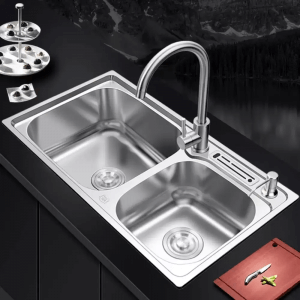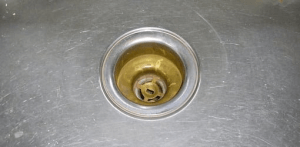
Don’t call the plumber each time you have a little leak or drainage problem in your kitchen. They aren’t cheap. They’ll charge a decent amount for their services. You can handle these small issues on your own, all with a little insight, and we’re here to give you just that!
How to remove kitchen sink drain? If this is what’s bothering you, we’ll help you out. After reading this post, you’ll be able to remove your kitchen sink drain on your own. You may even install a fresh one if the old, rusty one isn’t repairable.
Tools you’ll need
- Adjustable wrench
- Needle nose pliers
- Screwdriver
- Hammer
- A new strainer
- Plumber’s putty
Steps to follow to remove a kitchen sink drain
Now that you’ve gathered all your gear, it’s time for the fun part! Let’s save a few bucks and do our little plumbing chore on our own. Just follow the steps, and it shouldn’t be hard at all!
Step 1: Remove the drain pipe
Turn off the water tap before removing the hose. Now bend down under the sink and find a PVC pipe connected to it. You need to remove this pipe. Loosen the coupling nut that connects your sink to this PVC pipe. If you’re unable to turn the nut by hand, you can do so with the adjustable wrench that you have by your side.
Once you have loosened up the coupling nut, you will need to pull out the drain pipe to remove it from the sink.
Step 2: Loosen the strainer locknut
What holds the strainer basket attached to the sink is called a locknut. Using a locknut wrench or the adjustable wrench that you have, you can turn the locknut counterclockwise and remove it.
Sometimes, the rust on the old strainer makes it stick to the locknut and turn with it. You can use needlenose pliers applied from the top to prevent the old strainer from turning with the locknut.
Step 3: Remove the sink strainer
How to remove sink drain? Once you have loosened the locknut, you can easily pull it out by hand. Now give the old strainer a little shake using your hands and force it out of the sink from the other side. This step shouldn’t be hard, nor will it require any tools, once the locknut is loose.
Step 4: Remove the old putty
Before reusing the same sink strainer or attaching a new one, you should clean the sink thoroughly from both sides. Old plumber’s putty will need to be entirely removed before applying a new one so that the strainer, be it existing or new, can fit nicely without any leakages.
Use a plastic knife to scrape off the putty so that the surface of the sink doesn’t get any scratches.
Use sponge and some dish soap to clean the sink so that any grease, grime, or putty residue are removed before you reattach the strainer.
Steps to follow to attach a new sink strainer

Now that you’ve learned how to remove kitchen sink drain let’s find out how to attach a new one.
Follow the steps below to replace kitchen sink drain.
Step 1: Prepare the strainer
If you’re following the steps, you have already cleaned the sink, inside out. Now it’s time to clean the strainer that you’re going to attach. If the old strainer looks reusable, wash its underside thoroughly with some dish soap and water.
If you’re using a new strainer, detach all its parts and lay them out in front of you.
Step 2: Apply new putty
Now you have to apply some new plumber’s putty to seal the strainer to the sink. Make sure that both the sink and the strainer are clean and dry before using the putty. There are two different ways to go about it. You can choose whatever sounds easy to you:
- Apply on the sink
Usual way is applying plumber’s putty to the sink in the form of a ring, as shown in the picture. You have to take out a decent amount of putty from the container into your hand and knead it for a good while. Once it’s soft enough, roll it out by hand into a long cylindrical shape and apply it onto the sink by forming a ring in that shape. Press it to attach it tightly in place.
- Apply on the strainer
You can apply the same cylinder that you form by kneading the putty to the base on the underside of the strainer that you’re going to use.
Step 3: Attach the strainer
Now press the strainer down onto the sink with the putty sandwiched between them. Press it tightly enough so that you see the putty forced out from all sides of the strainer’s rim. Any excess putty that you see around the edge from the front side of the sink and also the bottom needs to be removed by a towel or using a plastic knife.
Step 4: Attach locknut
From the bottom of the sink, attach the washer, or washers, that come with the sink strainer. If you’re using the old strainer, be sure to use a new washer with it so that the connection is sealed, and there’s no leakage later on.
Now push in the locknut and turn it clockwise to tighten it using a wrench. Tighten it just enough to secure it in place but not to the extent that it breaks.
Step 5: Reattach the drain pipes
Now reattach the drain pipes by sliding the tailpiece nut onto the locknut at the bottom of the sink. Turn the metal nut clockwise using a wrench to tighten it. If it’s a PVC nut, you’ll have to tighten it with hand.
Step 6: Testing
Time to test run your project! Open the tap and let the water drain into the sink. Wait for a while and run dry paper towel around the sink’s bottom to see if there’s a leakage. Hopefully, you would have done the job beautifully and the paper towel will turn out completely dry.
Conclusion
That’s it! This was how to remove kitchen sink drain. You have a leak-free kitchen sink in under half an hour! No need to call in a plumber and pay him for a job you can do yourself. Use the same money to treat yourself for the fantastic job you’ve just done.

